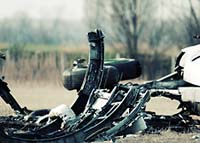 The Airbus A310-300 was flying the second leg of a longer flight that originated in Paris, officials said. The first leg of the journey, which involved a different aircraft—an Airbus A330—made a stop at Marseille before continuing on to Yemen.
The Airbus A310-300 was flying the second leg of a longer flight that originated in Paris, officials said. The first leg of the journey, which involved a different aircraft—an Airbus A330—made a stop at Marseille before continuing on to Yemen.It was there that passengers switched planes and boarded the ill-fated Airbus A310-300 for the final hop to Grand Comore.
According to the Times story the plane went down while on approach to Prince Said Ibrahim International Airport in Moroni. The plane was being buffeted by heavy winds before it went down in the Indian Ocean about 12 miles from the coast of Moroni. At the time of writing, five bodies along with a collection of debris had been found, but so far no survivors beyond the 5-year-old boy.
The plane crash early this morning represents the first fatal air accident for Yemenia Airways, according to the London-based consulting firm Ascend. The airline was founded in 1972 and maintains a fleet of 10 jet aircraft and five turboprop planes, ranging in age between five and 30 years. Prior to Tuesday's crash the airline's only passenger death occurred in June 2007, when a security guard opened fire on a group of employees of an international oil company who were disembarking from a Twin Otter turboprop at Al-Naeem, in southern Yemen.
However, despite the aforementioned record there have been questions raised as to the condition of the plane that went down this morning.
According to the French transportation minister the plane in question was last inspected by the French civil aviation authority two years ago. Dominique Bussereau indicated that inspectors "noticed a certain number of faults," when the aircraft was inspected in 2007.
However the plane had not returned to France since that inspection. The plane that carried passengers from the flight's origins in France was a different plane. The transport commissioner for the European Union, Antonio Tajani, stressed that the first plane had recently passed complete safety inspections in Europe. "We cannot control what happens outside the European Union," he said in the June 30th edition of the New York Times.
While French transportation authorities could not vouch for the safety of the plane that crashed beyond what they determined from the 2007 inspection, the transportation minister for Yemen indicated to Reuters that the plane had been inspected as recently as May of this year under supervision by experts from Airbus, the plane's manufacturer. "It was a comprehensive inspection carried out in Yemen," Khaled Ibrahim al-Wazeer said. "It was in line with international standards."
According to the Reuter's report the European Union's air safety committee asked Yemenia Airways a year ago to take unspecified 'corrective actions' to improve its performance with regard to safety. Tajani said that Yemenia Airways had "passed the checks" specified. The International Air Transport Association also said today that Yemenia Airways had passed a safety audit by its inspectors in the spring of 2008.
Reuters referred to a report on French radio that described an official of the airport at Moroni as saying the plane had lost radio contact with the tower at Moroni about five minutes before the crash is thought to have occurred.
According to the French Foreign Ministry there were 66 passengers of French decent on the doomed plane.
READ MORE Plane Crash LEGAL NEWS
The Airbus aircrafts involved in both crashes are some of the most technologically advanced planes in the skies. However, there have been problems. Two Quantas flights narrowly avoided disaster in recent years after automatic sensors and computers fed erroneous data to the pilots. And Airbus uses new, state-of-the-art composite materials in certain areas of its planes. The failure of a composite part was said to have played a role in a previous crash of an Airbus plane.
The investigation into the Yemenia Airways crash continues.
